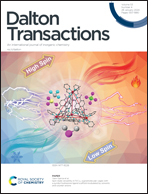Half-sandwich Ni(ii) complexes bearing enantiopure bidentate NHC-carboxylate ligands: efficient catalysts for the hydrosilylative reduction of acetophenones†
Abstract
Chiral nickel complexes containing NHC-carboxylate chelate ligands derived from the (S)-isomeric form of amino acids have been synthesised from the corresponding imidazolium salt and nickelocene. The presence of the carboxylate on the N-side arm of the heterocycle results in the competing formation of mixtures of mono- and bis-NHC complexes (i.e., [Ni(η5-Cp)(κ2-C,O-NHC)] and [Ni(κ2-C,O-NHC)2]), both of which retain the (S)-configuration of the stereogenic center and which can be separated by chromatography. Both the 18e− and 16e− complexes are found to be very stable and cannot be interconverted. The composition of the resulting mixtures depends mainly on the entity of the amino acid residue and, of more practical interest, on the reaction conditions. Thus, microwave heating and MeCN as a solvent favor the formation of the half-sandwich nickel complexes, rather than the bis-NHC compounds. Some of the [Ni(η5-Cp)(κ2-C,O-NHC)] complexes turn out to be among the best nickel catalysts for the hydrosilylative reduction of p-acetophenones described to date, although without chiral induction, in the absence of activating additives and under mild catalytic conditions.



 Please wait while we load your content...
Please wait while we load your content...